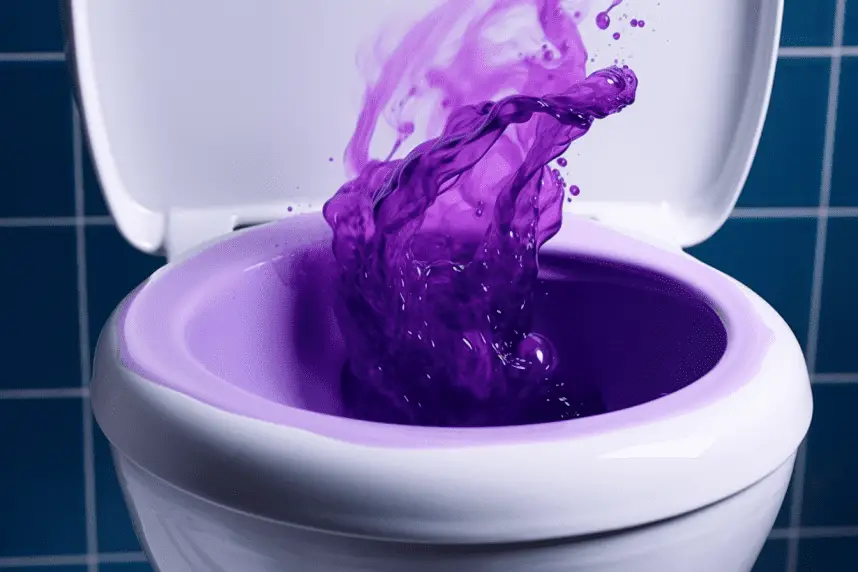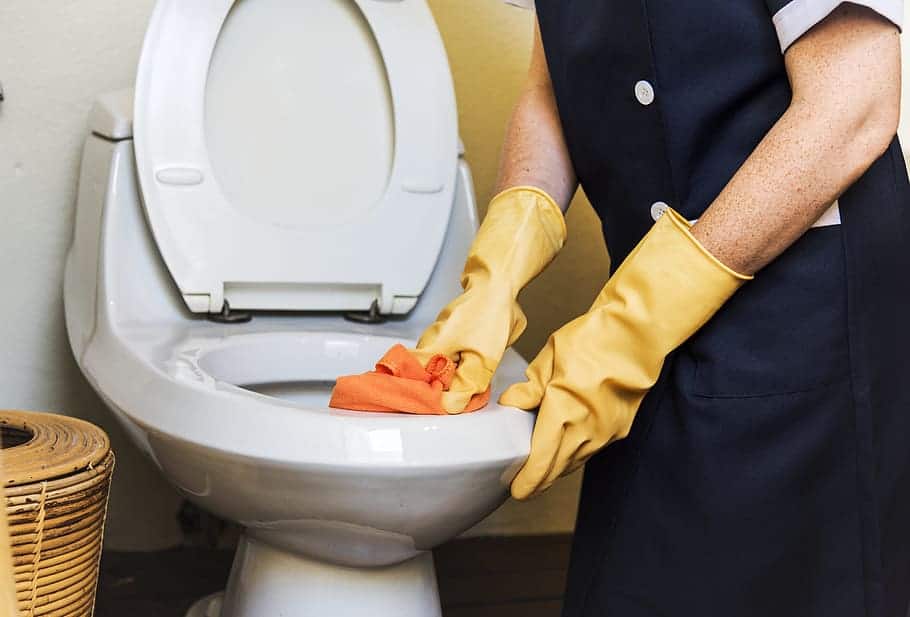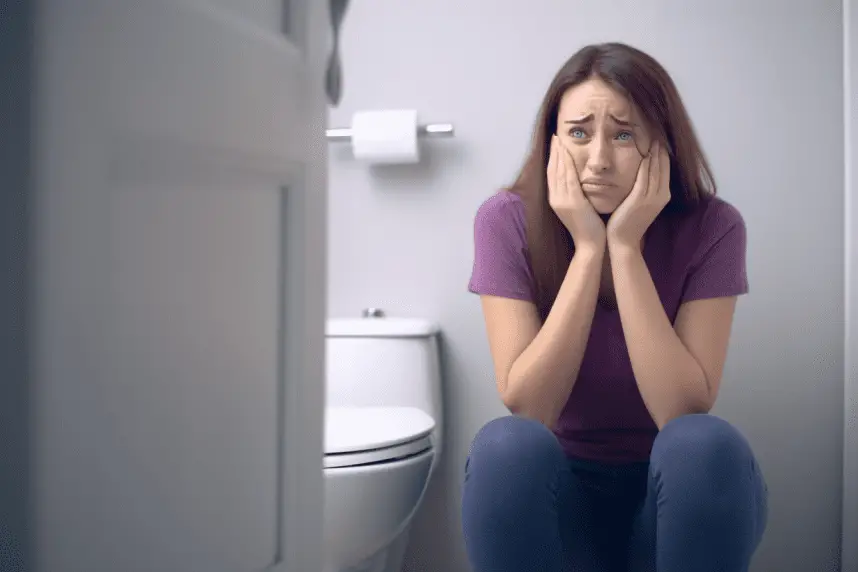You might have just stumbled upon the most baffling mystery of the century: purple water in your toilet! All right, that may be a bit of an exaggeration, but it’s certainly not something you see every day.
As a plumbing expert with years of experience under my belt, I’m here to help you unravel this perplexing situation and put your mind at ease.
Now, before we dive headfirst into the world of colorful toilet water, let’s take a moment to review some basics about your trusty porcelain throne. It’s essential to understand how your toilet works and its various components so we can pinpoint what could be causing this unexpected transformation.
So sit back, relax, and let me guide you through this potentially bewildering predicament.

Why Does My Toilet Water Turning Purple Water
There could be a few reasons why your toilet water is turning purple, and understanding the underlying cause can help you resolve the issue effectively.
One possible explanation for the purple hue in your toilet water could be chemical reactions taking place within your plumbing system or septic tank. Various substances present in your water supply, such as minerals, metals, or even bacteria, might interact with each other or with cleaning agents that you use in your bathroom. These interactions can sometimes result in color changes in the water. In some cases, local water treatment facilities might also add certain chemicals to the water supply for purification purposes, which can lead to discoloration if they react with other components in your plumbing.
Another factor that might contribute to purple toilet water is an issue with your plumbing system itself. For example, corroded pipes or fittings can release metal particles into the water flow, which subsequently reacts with other elements and leads to discoloration. Similarly, problems with septic systems can cause waste materials to mix with toilet water and alter their color.
It’s essential to have a professional plumber examine your plumbing setup if you suspect any of these issues are causing the purple hue in your toilet bowl. The next section will discuss potential health risks associated with this phenomenon and provide guidance on how best to address them.
What Are The Potential Health Risks Of Toilet Water Turning Purple
When toilet water turns purple, it’s most likely due to contamination. This could potentially lead to an increased risk of infection, so it’s important to take the necessary steps to ensure your water is safe.
Contamination
You’ve probably never expected to see your toilet water turn purple, right? Well, when it comes to contamination, there’s a whole lot that can go wrong in our plumbing systems.
As a plumbing expert, I’ve seen cases where purple staining occurs due to issues with water treatment processes. This could mean some harmful chemicals or contaminants accidentally mixed with your water supply.
It’s crucial to address this situation immediately and contact your local water supplier for an assessment; after all, we want to ensure the safety of our families at all times.
So, don’t ignore that peculiar hue – take action and prevent any potential health risks linked to the mysterious purple toilet water!
Infection Risk
Now that we’ve established the importance of addressing purple toilet water, let’s delve into its potential infection risks.
As I mentioned earlier, water contamination is possible in such cases, and it could lead to various health issues if left unattended.
Inadequate filtration methods or accidental mixing of chemicals can introduce harmful bacteria or toxins into your water supply.
You and your family might be exposed to these contaminants through direct contact with the water, or even by simply inhaling aerosolized droplets from flushing the toilet.
Therefore, it’s essential to take swift action and ensure proper assessment and remediation by your local water supplier – because when it comes to our health, there’s no room for compromise!
Troubleshooting Tips
Identifying the cause of why your toilet water is purple can be tricky, so let’s break it down. Finding solutions can be the next step, but we first need to figure out what’s causing the problem.

Identifying The Cause
Well, isn’t this a colorful conundrum? If your toilet water is turning purple, it’s likely due to some sort of contamination.
I’d first suggest checking for the presence of blue-green algae or bacteria growth in your toilet tank. These microorganisms can sometimes produce pigments that give the water an unusual hue. Don’t worry; we’ll get to the bottom of this without resorting to calling it magic!
Finding Solutions
So, what can we do to solve this perplexing purple problem?
First and foremost, you’ll want to address the possible presence of algae or bacteria. You can start by thoroughly cleaning your toilet tank with a bleach solution to eliminate unwanted growth.
It’s also crucial to consider water safety when dealing with these plumbing issues – you may want to have your water tested by a professional if you’re concerned about contamination.
By taking these steps, we’ll be well on our way to restoring your toilet water’s natural color and ensuring a safe and healthy home environment.
How To Test Water Quality
In a world where clear water is synonymous with cleanliness, discovering purple toilet water can be quite a shock. Fear not, for understanding the underlying cause of this peculiar phenomenon is the first step towards remedying it.
To ensure your water’s quality and safety, it’s essential to test its composition. Unusual colors in your toilet water may result from chemical reactions, mineral deposits or even certain types of bacteria.
There are several methods to evaluate your water quality and determine the root of the problem:
- Water filters: Check if your water filters are functioning correctly, as they can help remove impurities causing discoloration.
- Iron levels: Elevated iron levels in your water supply can lead to reddish or purple stains. Use an iron test kit to measure these levels.
- Hardness tests: Hard water contains high amounts of minerals like calcium and magnesium that can create scale buildup, leading to color changes in toilet water.
By performing these tests and identifying potential issues, you’ll be well-equipped to tackle any necessary adjustments or repairs to restore your toilet water back to its pristine state.
In the following section, we will delve into tips on how to clean your toilet tank effectively and maintain optimal sanitation standards.
How To Clean Toilet Tank
To effectively clean your toilet tank and address the issue of purple water, it is crucial to first understand the cause behind it. The discoloration could be attributed to various factors such as water chemistry, flushing habits, or even certain cleaning products.

For instance, if you have recently used a colored cleaning product, it may have temporarily tinted the water in your toilet tank. Moreover, if there is an issue with your water supply’s chemistry, it might cause a reaction with components within the tank leading to discolored water. It is also possible that debris buildup or mold growth due to poor flushing habits and improper maintenance can lead to changes in water color.
Before attempting to clean your toilet tank, ensure that you have identified the root cause of the problem. Addressing any potential issues with your water supply and plumbing system will help prevent further discoloration from occurring.
When cleaning the tank itself, take care not to use harsh chemicals that may exacerbate the problem or damage any components within the system. In case of tank leaks or fluctuations in water temperature affecting the color of the water, consult a professional plumber for guidance on how best to resolve such issues.
Once you’ve properly cleaned and maintained your toilet tank, you can move on to tackling any remaining traces of purple discoloration in your toilet bowl by following these steps on how to remove color from water.
How To Remove Color From Water
Like a magician’s trick gone awry, discovering purple water in your toilet can leave you both puzzled and concerned. Before we dive into the rabbit hole of how to remove the color from the water, let’s first identify possible causes.
Purple water is often a result of high manganese levels, which may have entered your water supply due to various reasons such as corroded pipes or natural minerals in the source. Other factors that might contribute to colored water include changes in plumbing systems and alterations in chlorine levels.
To restore your water’s transparency and ensure its safety, consider implementing these purification methods:
- Inspect your plumbing: Check for any visible corrosion or damage to pipes that may be causing the issue.
- Test your water: This will help determine if there are any contaminants present and pinpoint their sources.
- Adjust chlorine levels: If an imbalance in chlorine levels cause the problem, consult with a professional about adjusting them accordingly.
- Install a water filter: Water filters can remove impurities such as manganese and other contaminants from your plumbing system.
After taking these steps, your toilet’s once-mysterious purple liquid should return back to its crystal-clear state. However, if the issue persists even after trying all these solutions, it might be time to consult a professional plumber.
In our next section, we’ll explore what actions you can take when purple water refuses to vanish from sight.
What To Do If Purple Water Doesn’t Go Away?
If the purple water in your toilet doesn’t go away after a thorough cleaning, it may be time to consider some alternative solutions.

One possible reason for the persistent purple hue could be due to chemical reactions between the water and certain cleaning solutions or dye prevention products that you may have been using. To address this issue, try switching to milder, eco-friendly cleaning agents and avoid using any dye-based products in your toilet system.
Additionally, if you have hard water in your home, installing a water softener can help reduce mineral buildup that might be contributing to the discoloration.
Another important aspect to consider is odor control. If your toilet has a persistent unpleasant smell accompanying the purple water, it could indicate an issue with your plumbing system or septic tank. In this case, consult a professional plumber who can diagnose the problem and recommend suitable corrective measures.
Remember that addressing both color and odor issues simultaneously will ensure that your bathroom remains clean and comfortable for use. Now that we’ve discussed what to do if purple water doesn’t go away, let’s move on to understanding how we can prevent this issue from occurring in the first place.
Prevention Of Purple Water
Testing water quality is key to preventing purple water. It’s important to check for iron levels and other contaminants that could cause discoloration. Proper plumbing maintenance is also essential; regular inspections and repairs help ensure that your pipes are running smoothly. Finally, chemical balance control is essential to avoiding purple water – you’ll need to test and adjust pH levels to prevent staining.
Testing Water Quality
Ever wondered how you can avoid that startling sight of purple water in your toilet? Let’s talk about testing water quality!
As a plumbing expert, I can’t stress enough the importance of regularly checking your water supply for any contaminants. By incorporating water safety measures and proper home maintenance, you can prevent possible issues with your toilet water turning an unusual color.
Remember, it’s not only about keeping up appearances – ensuring the cleanliness of your drinking and household water is crucial for maintaining a healthy living environment.
So, don’t wait until you see those bizarre hues in your toilet bowl; be proactive and test your water quality today!
Proper Plumbing Maintenance
Now that we’ve discussed the importance of testing water quality, let’s delve into proper plumbing maintenance as a key factor in preventing purple toilet water.
Keeping your home’s plumbing system in tip-top shape is crucial to avoid any surprises down the line.
As a plumbing expert, I highly recommend investing in regular plumbing inspections and water purification systems to maintain a clean and healthy water supply.
This not only ensures that you won’t encounter any unwelcome tints in your toilet bowl but also protects your family from potential health risks associated with contaminated water.
So, don’t hesitate to take action – safeguard your home with proper plumbing maintenance today!
Chemical Balance Control
In addition to regular plumbing maintenance, it’s also vital to keep a close watch on your water’s chemical balance as part of preventing purple toilet water.
As a plumbing expert, I can’t stress enough the importance of having balanced pH levels and using water softeners if necessary.
You see, when your water’s pH levels are too high or too low, it can lead to various issues, including discoloration in your toilet bowl.
Water softeners can help prevent mineral buildup that could cause water discoloration as well.
So, don’t wait until you’re faced with an unsightly purple hue – take control of your home’s water quality by ensuring proper chemical balance and investing in the right solutions like water softeners for optimal results!
Frequently Asked Questions
Can Using Certain Cleaning Products Cause My Toilet Water To Turn Purple?
A mysterious purple hue swirls around the porcelain throne, a symbol of chemical reactions and water contamination lurking below the surface.
The culprit behind this colorful phenomenon may be certain cleaning products; sometimes, when these products mix with the water in your toilet bowl, they can create an unexpected purple tint.
DIY solutions like vinegar or lemon juice are popular bleach alternatives that can help avoid such color changes while still keeping the bowl clean.
Additionally, mineral deposits from hard water can contribute to discoloration and even affect how some cleaning agents react with the water.
As a plumbing expert, I recommend exploring eco-friendly options and checking for mineral buildup to maintain pristine toilet water without any surprising shades of purple.
Are There Any Specific Plumbing Issues That Could Lead To Purple Toilet Water?
There are certain plumbing issues that could potentially lead to purple toilet water.
Water contamination is a common cause, which may occur due to deteriorating plumbing pipes or even external factors affecting the water supply.
In some cases, a chemical reaction between the water and metal pipes can result in a purple hue.
Additionally, sanitation hazards like sewage leaks or improper water treatment can introduce harmful bacteria into your toilet water, causing it to change color.
It’s essential to address these plumbing issues promptly, as they not only affect the appearance of your toilet water but also pose potential health risks.
Can Purple Toilet Water Cause Stains Or Damage To My Toilet Bowl Or Other Bathroom Fixtures?
Hold on to your plungers, folks, because purple toilet water can cause stains and damage to your toilet bowl and other bathroom fixtures.
The interaction of bleach chemicals with certain minerals in the water can lead to unsightly discoloration and even promote bacteria growth.
Furthermore, these mineral deposits may accumulate over time, causing issues with water pressure and prompting the need for plumbing inspections.
To avoid a colorful catastrophe in your bathroom sanctuary, it’s crucial to address the root cause of purple toilet water and ensure that both your fixtures and plumbing system remain in tip-top condition.
Is It Safe To Use The Toilet For Flushing Waste When The Water Is Purple?
It’s generally safe to use the toilet for flushing waste when the water is purple, but it’s essential to investigate the cause of the color change.
Purple water could be due to testing pH levels using a dye, chemical reactions in your plumbing system, or even bacteria growth.
Additionally, pipe corrosion and water filters can contribute to this discoloration.
To ensure the safety and efficiency of your plumbing system, consult a professional who can identify and address any potential issues that may have led to the purple hue.
Do I Need To Call A Professional Plumber To Resolve The Issue Of Purple Toilet Water, Or Can I Attempt To Fix It Myself?
Interestingly, about 10% of homeowners experience plumbing leaks, which can contribute to discolored water.
When it comes to purple toilet water, you may be able to resolve the issue yourself or need the assistance of a professional plumber depending on the cause.
Dyeing toilets with certain cleaning products can result in purple water, which is a simple fix requiring no expert help.
However, if faulty pipes are causing chemical reactions leading to discoloration, it’s crucial to consult with a professional plumber to ensure water safety and prevent potential sewage buildup.
Ultimately, determining the root cause of the issue will dictate whether a DIY approach is sufficient or if calling in an expert is necessary for proper resolution.
Conclusion
I can’t help but sense the unease and confusion that purple toilet water may cause. With various potential reasons for the unusual color, it’s natural to feel concerned about what might be happening within your plumbing system or if there could be any hazardous consequences.
However, rest assured that there is light at the end of this perplexing tunnel. It’s been quite a journey exploring possible causes, from cleaning products to plumbing issues, and considering whether purple water poses any danger to you or your bathroom fixtures. Hopefully, throughout our discussion, we’ve provided some comfort in knowing that solutions exist for each scenario.
But what if the problem persists despite your best efforts? What do you do then? In that case, don’t hesitate to contact a professional plumber for assistance. They possess the expertise needed to properly diagnose and resolve whatever issue may be causing your toilet water to turn purple.
Remember, no matter how daunting this situation may seem now; help is available to guide you through it and restore normalcy in your bathroom once more.
